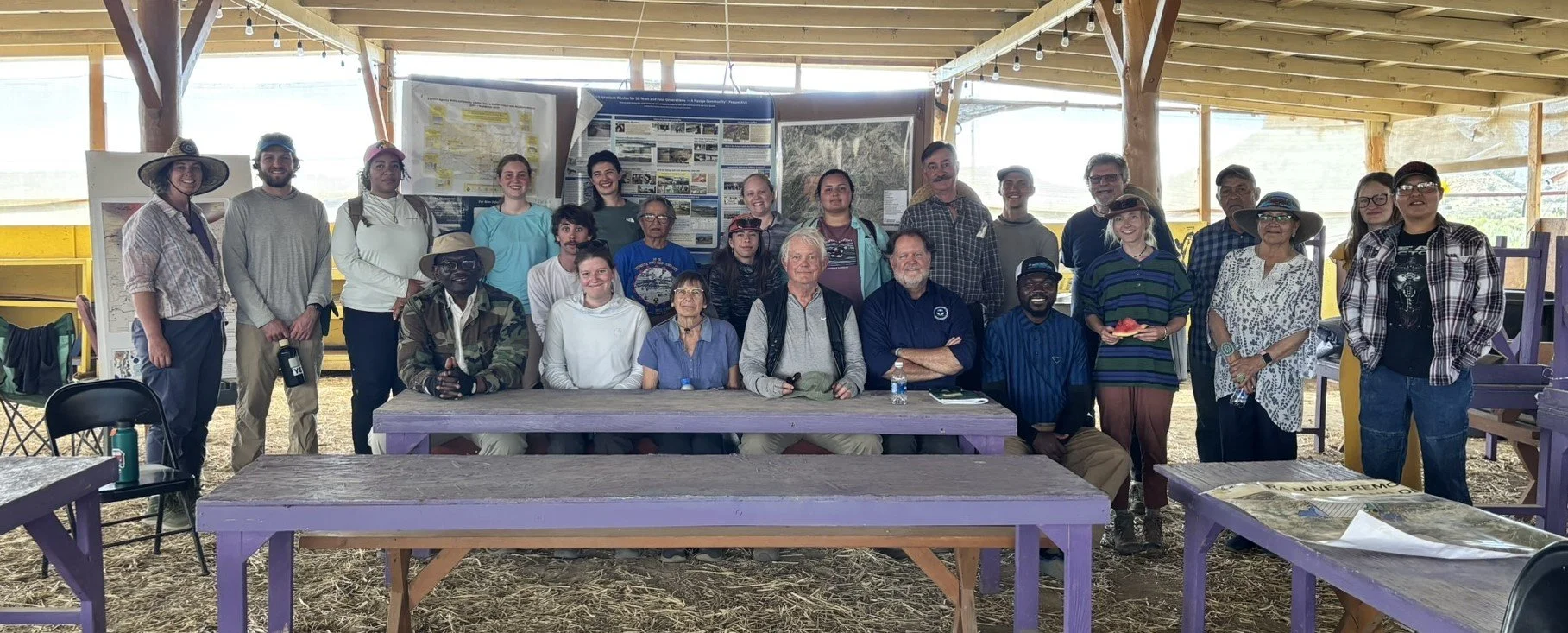Legacy to Lessons
In June 2025, students, industry professionals, and representatives from civil society gathered at Fort Lewis College in Durango for a week-long field course on environmental remediation and mine reclamation. Organized by the Western Alliance for Reclamation Management (WARM) with the Society of Economic Geologists (SEG), the June 22–29 course brought together 17 participants from Western Colorado University, Colorado School of Mines, Colorado State University, the University of Arizona, the University of Wisconsin–Milwaukee, and beyond.
WARM field course students and faculty join staff at the Lisbon Valley Copper Mine in Utah.
Led by WARM’s Board Chair David Gonzales (Fort Lewis College), Dominique Naccarato, and Luke Danielson (both of Western Colorado University), the group traveled through the Four Corners region of Colorado, Utah, Arizona, and New Mexico. This landscape, rich with geological resources and complex mining legacies, provided an immersive learning environment where participants explored abandoned uranium mines, copper operations, and large-scale reclamation projects. Site visits included the uranium-impacted communities of Shiprock, Church Rock in New Mexico, and Cove Area Mines in Arizona; the Lisbon Valley Copper Mine in Utah; and Colorado’s Bonita Peak Mining District.
The first two days focused on the Navajo Nation, where the effects of uranium mining remain significant. At Shiprock, Church Rock, and Cove, community members shared stories of displacement, health issues, and cultural loss—reminders that mining’s effects go far beyond just the environmental landscape. Federal, corporate, and tribal representatives from the U.S. Environmental Protection Agency (EPA), Department of Energy (DOE), Navajo Abandoned Uranium Mines, and Freeport-McMoRan outlined ongoing cleanup efforts. These include EPA and the Navajo Nation’s removal of nearly one million cubic yards of waste through CERCLA and a 2017 settlement with Freeport-McMoRan funding reclamation in the Cove area. Overall, these efforts highlighted that remediation needs not just technical solutions but also trust, accountability, and collaboration among governments, corporations, and Indigenous communities.
The WARM field course cohort joined Diné residents of the Red Water Pond Community and staff from the EPA and Southwest Research and Information Center.
On day three, attention shifted to the Lisbon Valley Copper Mine (LVCM) in Utah. Chief Geologist Brian Sparks introduced participants to the site’s geology, where copper occurs in Early Cretaceous formations and the overlying Dakota (Naturita) Sandstone along the downthrown northeastern side of the Lisbon Valley fault, with some zones reaching grades up to 5%. Brian explained operations involving open-pit mining, heap leaching, and Solvent Extraction-Electrowinning (SX-EW), which produce 99.99% pure copper cathodes from low-grade ore (~0.5% Cu). Participants examined remediation strategies, socio-economic considerations, and the company’s In-Situ Recovery (ISR) expansion plan—an effort to reduce environmental impacts while maintaining economic viability.
The course concluded in Colorado’s Bonita Peak Mining District (BPMD), which includes the well-known Gold King, Brooklyn, and Longfellow mines. Experts from EPA, the Colorado Geological Survey (CGS), Division of Reclamation, Mining and Safety (DRMS), Buka Consulting, Ensero Solutions Inc., and the Mountain Studies Institute (MSI) led the field sessions. Topics covered ranged from bulkheads and oxidation ponds used to manage acid mine drainage (AMD) to revegetation, fen ecosystem restoration, and assessing mine waste for potential resource recovery. Participants actively participated in water sampling and analysis, connecting classroom learning with practical, field-based application.
WARM field course students explore macroinvertebrates in Cement Creek to learn about reclamation efforts in the Bonita Peak Mining District.
Across the Four Corners, the course provided more than technical training. Participants grappled with the geopolitics of critical minerals, Indigenous land rights, mining policy, and the evolving role of communities, government, and industry in stewardship. With renewable energy and technology driving rising demand for copper, lithium, and other critical materials, discussions highlighted the dual challenge of reclaiming legacy sites while sourcing new resources responsibly. Some sessions explored how legacy waste itself might serve as a future supply of critical minerals.
Key highlights included observing bulkheads that control AMD, documenting radiation exposure, and witnessing innovative tools like spider excavators designed to operate on steep, unstable slopes. These experiences underscored the importance of integrating engineering innovation and nature-based solutions (NBS) with ecological restoration in contemporary mine reclamation.
For many, the field course’s greatest value was in its interdisciplinary exchange. Faculty, Indigenous representatives, and peers offered diverse perspectives, emphasizing that reclamation is as much cultural and social as it is scientific and technical.
Franklin Ngalim, a participant from Western Colorado University and environmental leader from Cameroon, reflected:
“My home country, like many developing nations, is navigating an intense extractive phase. Learning from the successes and mistakes of the U.S. mining boom provides insights we need to apply to ensure sustainability and justice in our own development paths.”
Ultimately, the WARM–SEG summer course demonstrated the power of field-based, interdisciplinary education. It offered not just lessons on mine reclamation techniques, but a deeper understanding of mining’s social and ecological aspects. By merging technical training with community voices, cultural context, and critical discussion, participants left equipped to address the legacies of mining while helping shape its future.
Special thanks go to WARM and SEG for enabling this transformative learning experience.
Donations to WARM, a 501(c)3 non-profit creating the next generation of mine reclamation professionals, support the summer field course and student scholarships. Please donate here and thank you for your support!



